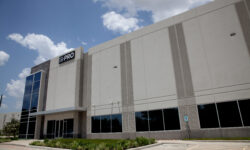How Investing in Intercoms Can Clear Up Critical Communications
Numerous benefits of ensuring intelligible audio systems via IP intercoms include enhancing situational awareness, bolstering surveillance and guard coverage, sending alarm notifications, elevating business efficiencies and more.

(Image courtesy of Zenitel)
There’s a famous quote by entrepreneur Marc Andreesen: “You are cruising along, and then technology changes. You have to adapt.” It’s true: not adapting can mean being left behind. It’s easy to become complacent since stability is something that humans naturally crave, but adapting is necessary.
Technology within the security industry has adapted to numerous changes through the years, from the early days of analog devices to today’s IP intercoms, networked cameras, and access control solutions, in addition to analytics, Cloud-based products, virtual security guards, and more.
It has adapted because facility security has changed to become a sophisticated risk management system. Protection of that system is multifaceted to include not only the interior and exterior of a building, but also the fence-line at the perimeter of a property. The strategy has evolved to interacting with employees, visitors, and vendors, sooner than before to mitigate security and safety risks.
Yet, no matter what security technology is in place, the need for clear communication always remains. Let’s take a look at various applications in which intelligible audio is crucial to everyday security.
Benefits of Sound in Security Scenarios
Think about how we hear, are heard and are understood. From a young age, we have been trained to respond to a voice or sound. How many times have you turned your head, or paused, when you heard a loud sound? Sound and voice add information to any situation, to help us determine if the situation is dangerous, or if everything is OK.
In a security situation, the benefits of audio are numerous. Audio can detect noises that are not within direct view of a video camera. It can also prevent harmful situations from happening. Someone waving at you as you walk into an area may be misconstrued as them simply saying hello in an aggressive manner. But their voice can help you to understand that what they really mean is “Stop! Don’t go in there.” Having audio is like adding “ears” to your “eyes” in any situation.
What else could be discerned from a situation when you include audio? Your security team can get more insight into an emergency or security situation, such as verbal cues like names, nicknames or languages that are spoken; levels of aggression; and sounds of a door opening or an alarm sounding.
Audio’s Extensive Use in Range of Applications
In enterprise security, it is exciting to witness how audio technologies are being leveraged to their full potential and being incorporated into facility security plans. For example, in manufacturing plants, high-definition audio solutions ensure that plant operators can communicate to the entire plant or to selected zones.
The perimeter can be protected via automated messages if an alarm is triggered. In buildings and facilities, audio and intelligent communication solutions provide instant communication in an elevator, at loading docks, at the reception desk, and in parking garages, to help employees, visitors or vendors who need it.
In hospitals, audio and intelligent communication solutions allow access and crystal-clear communication to restricted areas, cleanrooms and isolation rooms. They also allow quarantined patients in isolation rooms to communicate with staff without the risk of infecting others. In retail stores, instant voice communication is the key to delivering a quality customer experience, and intercom solutions and speakers provide direction to customers, help security guards to perform their jobs better, and enable communication between office staff and sales personnel.
Audio solutions in prisons provide communication assistance for visitors, cell communications, and with prison management systems to enhance a guard’s insight into situations and events. Audio also provides a secondary verification. For example, when a security guard sees something via video surveillance, all they need to do is push a button on an intercom solution and talk. If that person is lost or simply needs assistance, security can talk to them and provide directions and reassurance. Or, if that person demonstrates that they are there to cause damage or harm, the security officer can warn them they are being watched and heard.
The result could be a dangerous situation that is mitigated, as if someone knows they’re being watched, they are more likely to stop what they are doing and leave the scene. Beyond security, audio and video solutions improve enterprise business operations, such as customer service, where delivery drivers receive instructions on package receiving locations, and via audio and video with an intercom, verify that a shipment was delivered. Audio solutions also assist with directives for visitors.
For example, a patient who seeks access to a medical center for an appointment can hear important instructions from the medical staff via an intercom solution before they enter the facility.
Achieving Clear & Intelligible Audio
So we know that audio is not new to the security industry. IP intercoms, loudspeakers, two-way radios and emergency help stations are being used in multiple facilities every day. Yet, are all of those devices delivering crystal-clear audio? Imagine these scenarios:
- A visitor approaches an office entrance that is just off a busy street. They press the intercom button but have difficulty hearing and being heard.
- Workers in the warehouse need to speak to the front office, but when they place the call they have trouble hearing or be heard over the forklifts and fans.
- A delivery truck pulls up to a gate with a sign that says, “turn off engine before pressing intercom button.”
What’s being poorly handled in these situations? It’s the need for highly intelligible audio, every time. Is that need being met? If an intercom doesn’t allow the user to be clearly heard and understood, how can a security team depend on it for essential business functions?
With an IP intercom, how can clarity be achieved? What does it take to be heard and be understood, every time and everywhere? It’s the right combination of hardware, software and mechanics.

Intelligent communication solutions provide instant access in an elevator, at loading docks, at the reception desk, and in parking garages, to help employees, visitors or vendors who need it. (Image courtesy of Zenitel)
Right Combination of Intercom Features
The right hardware will incorporate the best microphone technology, such as a digital MEMS microphone. An analog microphone’s wires can work as an antenna, picking up electromechanical noise. A digital MEMS microphone uses an analog-to-digital converter and changes a voice to 0’s and 1’s, meaning that the signal is clear. This makes an intercom especially suitable for industry, railroad, elevator and parking applications.
A Class-D, 10W amplifier provides the ability for an amplified audio message that matches the environment where it is deployed. Creating quality sound also means that you need a speaker that can adjust to an increase in volume, so a matching 10W speaker is needed to effectively generate levels of intelligible voice audio to overcome high noise environments.
Then there are crucial software features that can deliver intelligible audio. Varying environments mean that the microphone and speaker need to continuously adjust for optimum performance in any situation. Automatic gain control is essential to meeting this demand, as it will take a voice that is too loud or too weak and level it out to an undistorted and clear signal.
It also means, for example, that drivers are no longer restricted to remain within close proximity of an intercom — no need to step out of a vehicle around unsafe areas in order to be heard. Active noise reduction will effectively remove unwanted noise components, leaving a clean speech signal, resulting in a clear Open Duplex (a technology that allows simultaneous communication between two active parties on an intercom system) conversation, even with a high noise level.
With Open Duplex, both the speaker and microphone on the stations are active at both ends at the same time, effectively making one-at-a-time intercom communication obsolete, and allowing for free-flowing, clear, and reliable communication. Last, native, onboard acoustic echo cancellation that can process audio reflections will prevent feedback and enable both people to talk at the same time, even at high volumes (95dB).
The mechanics of an intercom are important, as well. A traditional, vandal-resistant intercom speaker design will include two overlapping stainless-steel plates, which will trap some of the sound waves between them, creating a technical challenge called a standing wave. Instead, the intercom speaker grille should incorporate an anechoic design where there’s no reflection of sound waves as they pass through the intercom’s faceplate. As you raise the volume on an intercom without these features, you increase distortion and standing waves. That distortion and soundwave-induced vibrations are transferred into the intercom’s frame. Therefore, an intercom’s microphones should have a damping system to protect against the transfer of any sound vibrations.
Lastly, all mechanical components in an intercom must be mounted onto a rigid frame for the best performance. Here is where die-cast aluminum frames can be used to achieve crystal clear audio at any volume. Only that combination of hardware, software and mechanics will ensure clear audio, clear sound and clear communications. When we understand what is intelligible, we can then look to technology to change the expectation and to deliver clear audio at levels not experienced before.
Adapting Even Further
Security technology has adapted and changed in response to security and safety risks. It’s exciting that the adaption has included IP intercoms and audio solutions. They are a vital tool to strengthen security and to optimize facility communications and integration, both onsite and offsite.
But there is still work to be done. Further adaptations need to always include clear audio that is into a video surveillance and access control plan. Not considering clear audio is missing a key step to providing a complete system that allows a facility and security team to meet the security and safety needs of its employees and visitors. Every IP intercom and audio solution that you install should provide clear and intelligent communications, no matter the environment.
Peter Sandin is Northeast Regional Sales Manager at Zenitel.
If you enjoyed this article and want to receive more valuable industry content like this, click here to sign up for our FREE digital newsletters!

Security Is Our Business, Too
For professionals who recommend, buy and install all types of electronic security equipment, a free subscription to Commercial Integrator + Security Sales & Integration is like having a consultant on call. You’ll find an ideal balance of technology and business coverage, with installation tips and techniques for products and updates on how to add to your bottom line.
A FREE subscription to the top resource for security and integration industry will prove to be invaluable.







